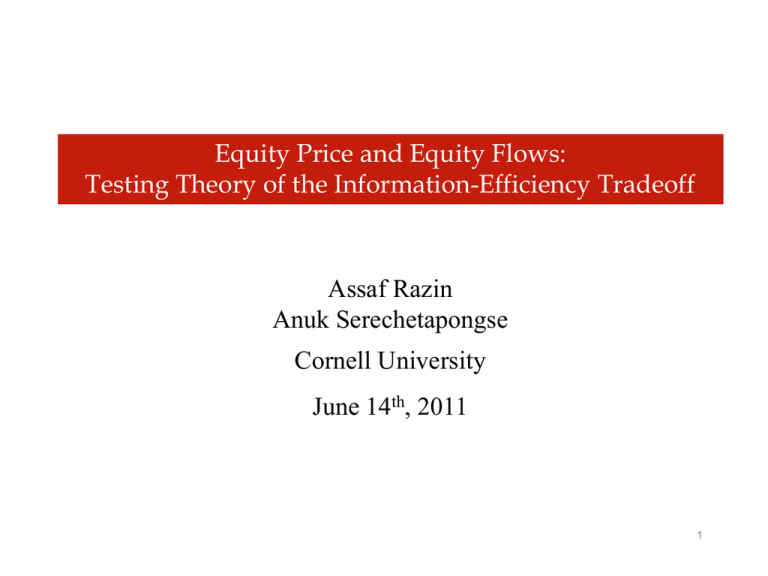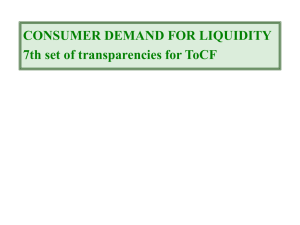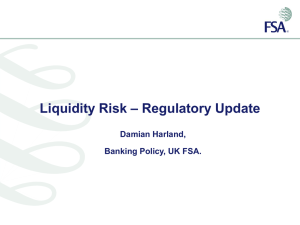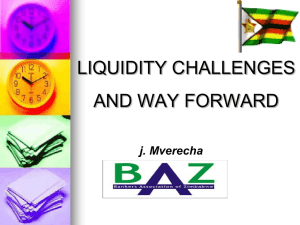Equity Composition Hypothesis
advertisement

Equity Price and Equity Flows: Testing Theory of the Information-Efficiency Tradeoff Assaf Razin Anuk Serechetapongse Cornell University June 14th, 2011 1 Capital market liberalization gave rise to large amount of international equity investments, which are I. Foreign Direct Investments (FDI) II. Foreign Equity Investments (FPI) 2 How do different types of international equity investments interact amid the risk of liquidity crisis? Goldstein and Razin (2006): When FDI is sold, the market does not know whether it is sold because of liquidity shock or because of low productivity. Hence, the price direct investment must incur informational discount if sold before maturity. As a result, investors would tilt their investments towards FPI if they expect greater liquidity needs. 3 How do different types of international equity investments interact amid the risk of liquidity crisis? Kirabaeva (2009): On one hand, as a fraction of direct investors increases, the price of direct investment goes down On the other hand, as we have more direct investors with higher liquidity risk, it is more likely that a direct investment is sold due to liquidity needs. This improves the price of the prematurely sold direct investment. 4 Three testable hypotheses: I. Price Discount Hypothesis – the FDI-to-FPI price differential is negatively related to the risk of liquidity crisis II. Equity Composition Hypothesis – the FDI-to-FPI composition of foreign equity investment skews towards FPI when investors are expected to experience liquidity shortage in the future III. Strategic Complementarity Hypothesis – the FDI-to-FPI composition of foreign equity investment will skew towards FDI if the initial proportion of FDI-to-FPI is large 5 Measure of FDI-to-FPI Ratio The data of FDI-to-FPI ratio is from Lane and Milesi-Ferretti (2007) The sample period is from 1970 – 2004 They distinguish four types of international assets and liabilities: foreign direct investment, foreign portfolio(equity) investment, official reserves, and external debt The outward FDI and FPI from the source countries are measured using the data of the stock of FDI and equity assets. The inward FDI and FPI into the host countries are measured using 6 the data of the stock of FDI and equity liabilities. Proxy of Liquidity Crisis: As in Goldstein, Razin, and Tong (2007), the proxy of a liquidity crisis is the incident when a purchase of external assets is negative (or a sales of external assets is positive) When a country faces liquidity crisis, many types of assets, such as reserves, direct investments, equity investments, and other assets, will be sold 7 Measures of a Liquidity Crisis I. Liquidity Crisis Severity If the purchase of external assets is negative, Liquidity Crisis Severity = sales of external assets total assets If the purchase of external assets is positive, Liquidity Crisis Severity = 0 8 Measures of a Liquidity Crisis I. Liquidity Crisis Dummy II. Liquidity Crisis Dummy • Liquidity Crisis Dummy Liquidity Crisis Dummy = = 1 ; if the purchase of external assets is negative 0 ; otherwise These measures are estimated using the data on annual flows in external assets from the IMF’s Balance of Payments dataset. 9 Empirical Methodology The liquidity crisis severity and dummy variables will be instrumented on the following excluded instruments: 1.Current account balance to GDP 2. Government budget balance to GDP 3. The ICRG political risk measure 4. The ICRG financial risk measure Then the instrumented liquidity crisis variable will be used as an explanatory variable of interest in the structural equations that will test the three hypotheses. 10 Testing the Price Discount Hypothesis ln(PFDI/PFPI)i,t = ηWi,t + ζ0(Instrumented Liquidity Crisisi,t+1) + yeart + ui + i,t where ln(PFDI/PFPI)i,t = the log of FDI price to FPI price Instrumented Liquidity Crisisi,t+1 = the liquidity crisis dummy or the liquidity crisis severity in the next period (instrumented) Wi,t = controls (log of GDP, log of GDP per capita, inflation) 11 Testing the Price Discount Hypothesis PFPIi,t will be proxied by the stock market index PFDIi,t will be proxied as follow, PFDIi,t = ωPmarketi,t + (1-ω)Pearningsi,t where ω is the share of the market component of FDI over the total FDI inflows Pmarketi,t will be proxied by the stock market index 12 Testing the Price Discount Hypothesis Pearningsi,t will be estimated using the method in del Rio (2004) Pearningsi,t = pi*[(ci*cgdp)/(ki*rgdpl)] where pi = the PPP price level of investment cgdp = GDP per capita at world price ci = the investment share of cgdp rgdpl = GDP per capita at constant world price ki = the investment share of rgdpl 13 The Effect of Liquidity Crisis on the FDI to FPI Price Ratio (Fixed Effects) 14 Testing the Equity Composition Hypothesis ln(FPI/FDI)i,t = Xi,t + 0(Instrumented Liquidity Crisisi,t+1) + yeart + ui + i,t where ln(PFDI/PFPI)i,t = the log of FDI price to FPI price Instrumented Liquidity Crisisi,t+1 = the liquidity crisis dummy or the liquidity crisis severity in the next period (instrumented) Xi,t = controls 15 Testing the Equity Composition Hypothesis Controls: From Goldstein, Razin, and Tong (2007) 1. log of GDP 2. log of GDP per capita at a constant price 3. log of stock market capitalization 4. natural log of trade openness (export plus import to GDP) 5. lag of real exchange rate From Chinn and Ito (2005) 6. GDP deflator 16 The Effect of Liquidity Crisis on the Outward FPI to FDI Ratio 17 The Effect of Liquidity Crisis on the Outward FDI (Level) 18 The Effect of Liquidity Crisis on the Outward FPI (Level) 19 Testing the Strategic Complementarity Hypothesis ln(FPI/FDI) i,t = Xi,t + 0(Instrumented Liquidity Crisisi,t+1) +1(Instrumented (FDI/All Inward Capital)i,t-1*( Liquidity Crisisi,t+1) ) +yeart + ui + i,t where ln(FPI/FDI)i,t = the log of FPI outflows to FDI inflows Liquidity Crisisi,t+1 = the liquidity crisis dummy or the liquidity crisis severity in the next period (FDI/All Inward Capital)i,t-1 = the initial fraction of direct investment Xi,t = controls 20 The Effect of Liquidity Crisis and the Initial Direct Investment Portion on the Outward FPI to FDI Ratio (Fixed Effects) 21 The Effect of Liquidity Crisis and the Initial Direct Investment Portion on the Outward FPI to FDI Ratio (Dynamic Panel) 22 Robustness Tests: 1. Run the regression on the level of M&As 2. Add one additional variable, capital account openness index Main results don’t change 23 Conclusion The empirical results give strong support for the three hypotheses Greater expected liquidity problems increase the price discount, have a significant negative effect on the gross outward FDI, and positive effect on the ratio between FPI and FDI 24









